Related Research Articles

A corona is the outermost layer of a star's atmosphere. It is a hot but relatively dim region of plasma populated by intermittent coronal structures known as solar prominences or filaments.
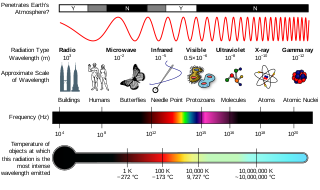
The electromagnetic spectrum is the full range of electromagnetic radiation, organized by frequency or wavelength. The spectrum is divided into separate bands, with different names for the electromagnetic waves within each band. From low to high frequency these are: radio waves, microwaves, infrared, visible light, ultraviolet, X-rays, and gamma rays. The electromagnetic waves in each of these bands have different characteristics, such as how they are produced, how they interact with matter, and their practical applications.

In physics, radiation is the emission or transmission of energy in the form of waves or particles through space or a material medium. This includes:
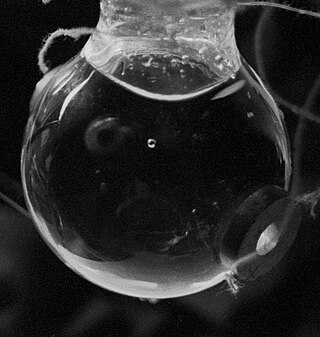
Sonoluminescence is the emission of light from imploding bubbles in a liquid when excited by sound.

In astronomy, the interstellar medium (ISM) is the matter and radiation that exists in the space between the star systems in a galaxy. This matter includes gas in ionic, atomic, and molecular form, as well as dust and cosmic rays. It fills interstellar space and blends smoothly into the surrounding intergalactic space. The energy that occupies the same volume, in the form of electromagnetic radiation, is the interstellar radiation field. Although the density of atoms in the ISM is usually far below that in the best laboratory vacuums, the mean free path between collisions is short compared to typical interstellar lengths, so on these scales the ISM behaves as a gas (more precisely, as a plasma: it is everywhere at least slightly ionized), responding to pressure forces, and not as a collection of non-interacting particles.

In physics, a shock wave, or shock, is a type of propagating disturbance that moves faster than the local speed of sound in the medium. Like an ordinary wave, a shock wave carries energy and can propagate through a medium but is characterized by an abrupt, nearly discontinuous, change in pressure, temperature, and density of the medium.

The effects of a nuclear explosion on its immediate vicinity are typically much more destructive and multifaceted than those caused by conventional explosives. In most cases, the energy released from a nuclear weapon detonated within the lower atmosphere can be approximately divided into four basic categories:
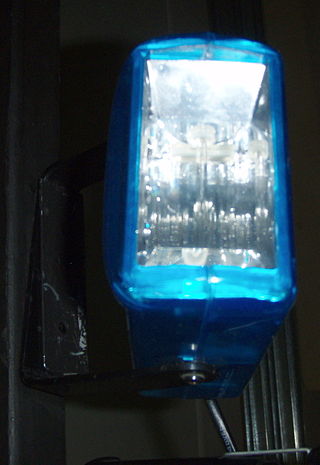
A strobe light or stroboscopic lamp, commonly called a strobe, is a device used to produce regular flashes of light. It is one of a number of devices that can be used as a stroboscope. The word originated from the Ancient Greek στρόβος (stróbos), meaning "act of whirling".

The exploding-bridgewire detonator is a type of detonator used to initiate the detonation reaction in explosive materials, similar to a blasting cap because it is fired using an electric current. EBWs use a different physical mechanism than blasting caps, using more electricity delivered much more rapidly. Exploding with more precise timing after the electric current is applied, by the process of exploding wire method. This has led to their common use in nuclear weapons.

A flashtube (flashlamp) is an electric arc lamp designed to produce extremely intense, incoherent, full-spectrum white light for a very short time. A flashtube is a glass tube with an electrode at each end and is filled with a gas that, when triggered, ionizes and conducts a high-voltage pulse to make light. Flashtubes are used most in photography; they also are used in science, medicine, industry, and entertainment.
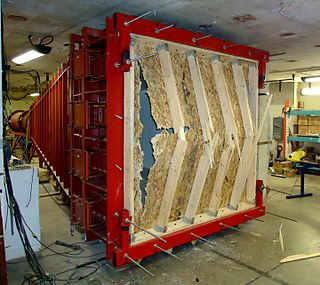
The shock tube is an instrument used to replicate and direct blast waves at a sensor or a model in order to simulate actual explosions and their effects, usually on a smaller scale. Shock tubes can also be used to study aerodynamic flow under a wide range of temperatures and pressures that are difficult to obtain in other types of testing facilities. Shock tubes are also used to investigate compressible flow phenomena and gas phase combustion reactions. More recently, shock tubes have been used in biomedical research to study how biological specimens are affected by blast waves.

High voltage electricity refers to electrical potential large enough to cause injury or damage. In certain industries, high voltage refers to voltage above a certain threshold. Equipment and conductors that carry high voltage warrant special safety requirements and procedures.
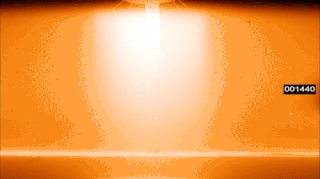
Rope trick is the term given by American nuclear physicist John Malik to the curious lines and spikes which emanate from the fireball of nuclear explosions under certain conditions, just after detonation.

Inductively coupled plasma atomic emission spectroscopy (ICP-AES), also referred to as inductively coupled plasma optical emission spectroscopy (ICP-OES), is an analytical technique used for the detection of chemical elements. It is a type of emission spectroscopy that uses the inductively coupled plasma to produce excited atoms and ions that emit electromagnetic radiation at wavelengths characteristic of a particular element. The plasma is a high temperature source of ionised source gas. The plasma is sustained and maintained by inductive coupling from electrical coils at megahertz frequencies. The source temperature is in the range from 6000 to 10,000 K. The intensity of the emissions from various wavelengths of light are proportional to the concentrations of the elements within the sample.
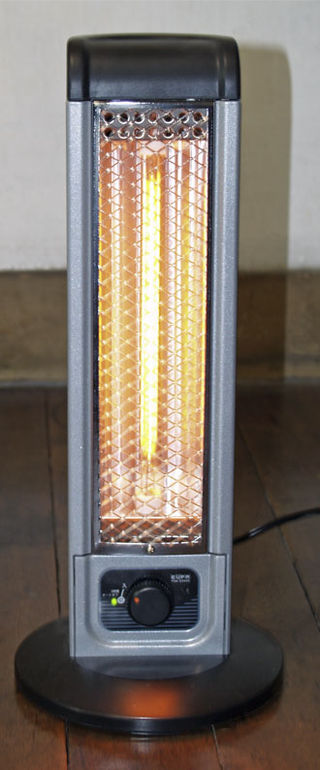
An infrared heater or heat lamp is a heating appliance containing a high-temperature emitter that transfers energy to a cooler object through electromagnetic radiation. Depending on the temperature of the emitter, the wavelength of the peak of the infrared radiation ranges from 750 nm to 1 mm. No contact or medium between the emitter and cool object is needed for the energy transfer. Infrared heaters can be operated in vacuum or atmosphere.
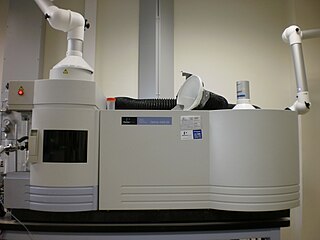
Atomic emission spectroscopy (AES) is a method of chemical analysis that uses the intensity of light emitted from a flame, plasma, arc, or spark at a particular wavelength to determine the quantity of an element in a sample. The wavelength of the atomic spectral line in the emission spectrum gives the identity of the element while the intensity of the emitted light is proportional to the number of atoms of the element. The sample may be excited by various methods.
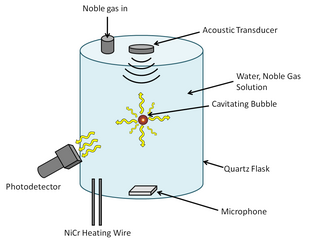
Sonoluminescence is a phenomenon that occurs when a small gas bubble is acoustically suspended and periodically driven in a liquid solution at ultrasonic frequencies, resulting in bubble collapse, cavitation, and light emission. The thermal energy that is released from the bubble collapse is so great that it can cause weak light emission. The mechanism of the light emission remains uncertain, but some of the current theories, which are categorized under either thermal or electrical processes, are Bremsstrahlung radiation, argon rectification hypothesis, and hot spot. Some researchers are beginning to favor thermal process explanations as temperature differences have consistently been observed with different methods of spectral analysis. In order to understand the light emission mechanism, it is important to know what is happening in the bubble's interior and at the bubble's surface.
The exploding wire method or EWM is a way to generate plasma that consists in sending a strong enough pulse of electric current through a thin wire of some electrically conductive material. The resistive heating vaporizes the wire, and an electric arc through that vapor creates an explosive shockwave.

Heating films are a method of electric resistance heating, providing relatively low temperatures over large areas. Heating films can be directly installed to provide underfloor heating, wall radiant heating and ceiling radiant heating.
References
- 1 2 3 4 Explosive-driven shock waves in argon, William C. Davis, Terry R. Salyer, Scott I. Jackson, and Tariq D. Aslam, Los Alamos National Laboratory
- ↑ Rudolf Meyer; Josef Köhler; Axel Homburg (2007). Explosives. Wiley-VCH. p. 21. ISBN 978-3-527-31656-4.
Argon flash.
- ↑ Sidney F. Ray (1999). Scientific photography and applied imaging. Focal Press. p. 445. ISBN 0-240-51323-1.
- 1 2 Lalit C. Chhabildas; Lee Davison; Yasuyuki Horie (2005). High-pressure shock compression of solids VIII: the science and technology of high-velocity impact. Springer. p. 263. ISBN 3-540-22866-7.
- ↑ "Argon flash (Arno Hahma)". Yarchive.net. 1999-01-29. Retrieved 2010-03-23.
- ↑ Todd Jr, J; Parsons, D (1957-01-11). "Technical Report: High-Explosive Argon Flash Light Source". Osti.gov. doi: 10.2172/4310914 . OSTI 4310914.